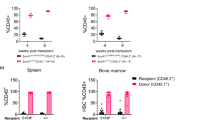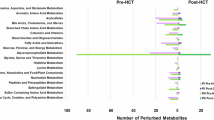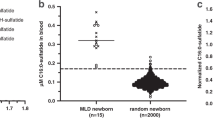Abstract
Extract: Arylsulfatase B activity was studied in peripheral leukocytes obtained from 11 normal subjects, 2 obligate heterozygotes for Maroteaux-Lamy syndrome (MLS), and 1 homozygote for MLS. The activity (mean ± SD) was 113.7 ± 36.2 (range 57.4 181.8), 31.0 (25.7–34.5), and 5.0 nmol 4-nitrocatechol/mg protein/hr, respectively. Although overlap occurred on two occasions between adjacent groups on single enzyme determinations, no overlap was observed between normal subjects, heterozygotes, and the homozygote when the mean activities of replicate assays performed were considered. In two normal siblings of the patient, sibling I and sibling 2, the activity was 50.1 and 106.3, respectively. Arylsulfatase B activity in cultured skin fibroblasts derived from 14 normal subjects, the 2 obligate heterozygotes for MLS, and the patient was 145.2 ± 4.6 (82.7–178.7), 58.5 (49.3–67.6), and 7.0, respectively. Occasional overlap between normal subjects and heterozygotes again occurred with single enzyme determinations, but there was no overlap between the mean values of replicate assays performed on each case. Sibling 1 and sibling 2 showed activity of 51.0 and 96.0, respectively, confirming the leukocytes. Arylsulfatase B activity in cultured skin fibroblasts of 11 patients with 7 other inborn errors of metabolism, including patients with Hurler's syndrome, Hunter's syndrome, and metachromatic leukodystrophy was within normal range. The lysosomal enzymes arylsulfatase A (EC. 3.1.6.1), α-D-galatosidase (EC. 3.2.1.22), α-glucosidase (EC. 3.2.1.20), α-L-iduronidase (EC. 3.2.1.76), α-D-mannosidase (EC. 3.2.1.24), α-L-fucosidase (EC. 3.2.1.51), β-D-galactosidase (EC. 3.2.1.23), β-D-glucosidase (EC. 3.2.1.21), and β-D-glucuronidase (EC. 3.2.1.31) were normal in cultured skin fibroblasts of the patient with MLS. No arylsulfatase B activity was detected in a long term lymphoid cell line established from the patient with MLS. The arylsulfatase B activity in 10 normal lymphoid cell lines was 25.2 ± 5.6 with a range of 15.8–31.8. In cultured amniotic fluid cells from 10 normal pregnancies the arylsulfatase B activity was 203.2 ± 49.9, with a range of 136.3–302.7. The findings indicate that peripheral leukocytes, cultured skin fibroblasts, and long term lymphoid cell lines can be used for the diagnosis of MLS, and that carrier detection is possible. Also the finding of arylsulfatase B activity in cultured amniotic fluid cells suggests that prenatal diagnosis of MLS is feasible.
Speculation: Deficiency of arylsulfatase B is the basic metabolic defect in Maroteaux-Lamy syndrome. This enzyme probably catalyzes the cleavage of sulfate from the sulfated N-acetylgalatosamine contained in dermatan sulfate. Its deficiency would result in tissue accumulation and urinary excretion of this mucopolysaccharide.
Similar content being viewed by others
Log in or create a free account to read this content
Gain free access to this article, as well as selected content from this journal and more on nature.com
or
Author information
Authors and Affiliations
Rights and permissions
About this article
Cite this article
Beratis, N., Turner, B., Weiss, R. et al. Arylsulfatase B Deficiency in Maroteaux-Lamy Syndrome: Cellular Studies and Carrier Identification. Pediatr Res 9, 475–480 (1975). https://doi.org/10.1203/00006450-197505000-00003
Issue date:
DOI: https://doi.org/10.1203/00006450-197505000-00003
Keywords
This article is cited by
-
Expression, activity and localization of lysosomal sulfatases in Chronic Obstructive Pulmonary Disease
Scientific Reports (2019)
-
Arylsulfatase B regulates colonic epithelial cell migration by effects on MMP9 expression and RhoA activation
Clinical & Experimental Metastasis (2009)
-
Autologous transplantation of retrovirally transduced bone marrow or neonatal blood cells into cats can lead to long-term engraftment in the absence of myeloablation
Gene Therapy (1999)
-
Triplex gene dosage effect for β-glucronidase and possible assignment to band q22 in a partial duplication 7q
Human Genetics (1981)
-
Hurler-Scheie phenotype: A report of two pairs of inbred sibs
Human Genetics (1979)



